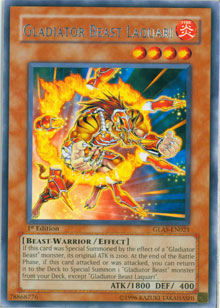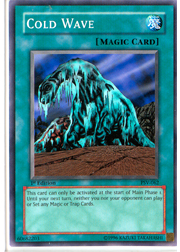I find it very useful to be aware of the simple math you can use to play your hands better. Winning is more than just playing a fantastic deck. A deck cannot win the game all on its own. Even the most robotic strategies can lose in the hands of a poor decision-maker. The deck is not the cause of the desired effect (winning the match)—it is merely a means to that end. Ultimately, your mental ability is the cause of your success.
In high-stakes game situations where one false move could turn victory into defeat, it becomes increasingly important to be aware of what your opponent can play from his or her hand. It’s also vital that you are aware of how many ways he or she can play that hand and rate those possibilities accordingly. This is starting to sound tricky, right? It’s not as bad as you think. Let’s go over a few math rules pertaining to permutations and combinations.

Permutations
Instead of arranging the cards in your head this way (which takes forever), you can use something called the fundamental counting rule. There are three ways to select the first card, two ways to select the second card, and one way to select the last card. Hence, as the rule says, there are 3 x 2 x 1 = 6 ways to play these cards in succession. An easier way of doing this would be to use a high school math concept called factorial notation. You can simply say that there are 3! ways to play those three cards in a row. The "!" is short-hand used to describe 3 x 2 x 1.
In our example, all of the cards in our hand were used. However, we know that there are situations in which only some of the cards would be used. Let’s say that your opponent has six cards in his or her starting hand and you know that the opponent will only play two or three of them on turn 1. How many ways can your opponent play the three cards out of six? Without regard to game mechanics, let’s assume that the opponent can play any two or three of that player’s six cards this turn. If this is a bit too confusing (which, I admit, it may be) let’s further paint the picture by using a recent example: game 3 of the U.S. Nationals match betweenShane Scurry and Chris Bowling, two exceptional players.
Scurry opened and, taking into account his six-card hand and the standard play of two to three cards in a row, he can make that standard play in one of 30 or 120 ways respectively. How did I determine that? Using the permutation rule: nPr = n! / (n-r)!
In plain English, this means: the arrangement of n objects in a specific order using r objects at a time is called a permutation of n objects taking r objects at a time. So if we write out our scenario using the permutation rule, we get this:
6! divided by (6-2)! = 6! / 4! = 6 x 5 x 4! / 4!
To make this function simpler, we can cancel out the two 4! to get 6 x 5, which equals 30. That was only using two cards. Let’s try using three cards out of six.
6! / (6-3)! = 6! / 3! = 6 x 5 x 4 x 3! / 3!
Cancel out the two 3! and you get 6 x 5 x 4 which equals 120. It’s nearly impossible to determine exactly what play he will make at this point if you take into account the number of distinct ways he can play three cards out of six. That’s too imprecise for Chris to make an accurate guess. He needs a simpler method and a smaller number. Instead of counting the number of distinct ways Shane can play those two or three cards out of six, let’s just count them without any regard to order.

Combinations
6! / (6-2)!2! = 6! / 4!2! = 6 x 5 x 4! / 4!2!
When we cancel the two 4!, we get 30/2, which equals fifteen ways. Let’s see how many ways he can play three cards.
6! / (6-3)!3! = 6! / 3!3! = 6 x 5 x 4 x 3! / 3!3!
When we cancel out the two 3!, we get 120/6 which equals twenty ways.
With the combination rule, we can determine that any player, regardless of game mechanics or order, can play two or three cards out of his six-card starting hand fifteen to twenty ways. Anybody can reasonably guess the fifteen to twenty plays you can make considering Shane Scurry’s deck (i.e. Gladiator Beasts). Chris can further narrow this number down by taking into account game mechanics such as summoning restrictions, activation conditions, etc. For example, Shane can only play Cold Wave at the start of his main phase 1. That eliminates a lot of possible plays.
Implications
So why is this math stuff important anyway? Because you can use it at any point during the game once you get good at it. I think that, by determining the number of ways your opponent can play his or her current hand, you can determine what cards would be required to make those plays. Obviously, this method is very inefficient at the start of the game when you have no information about your opponent’s cards, but as the game wears on, your opponent will inevitably reveal more information about his or her deck—both the cards in the deck as a whole, and the cards he or she has access to in a particular instance. Keeping in mind that most popular decks have very few variations in their basic structure, you can make quite a few accurate bets as to what your opponent can and cannot do in certain situations. The more information you can obtain from your opponent, the better off you are in the long run.
If you’ve already learned how to do this without having to learn the math, then that’s good. There are many players out there who have gotten very good at this game without any need to calculate probabilities and combinations. You can do this in poker, too. However, I think that learning to use this math instead of going through the grueling hours of practice can speed up the learning process and will ultimately put you ahead of those who rely on natural ability without the math. We have a lot of shortcuts built into our brains in order to memorize past mistakes, to recognize similar patterns in different game situations, and to make educated guesses based on those memories, but those take a long time to build up, and you may not have the same ability as the "naturals."
Why not use the math as your primary tool so you can reach wonderful in-game conclusions like: "Let’s see . . . I know that he can play his current hand one of twelve ways and I can successfully counter ten of those twelve this turn. Fortunately, the two ways I can’t counter would require a lot of heavy thinking on his part. He’d most likely opt for the easier, less risky plays that I’m prepared for." In my opinion, that’s worth the effort. Try to use the math in your next testing session and see if you can turn it into a habit of mind.
—Bryan Camareno